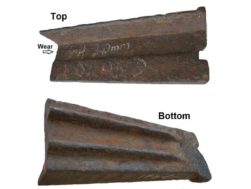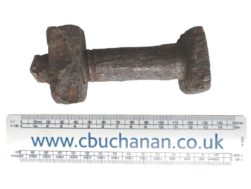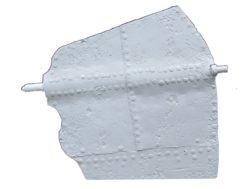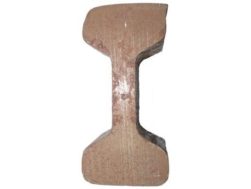Description
An interconnecting wrought iron chain link with pin attached, one of three from Capt Samuel Brown’s Union Chain Bridge over the Tweed at Paxton, Berwickshire 1819-20. Link dimensions: 11.5 in (292 mm) x 1.25 in (32 mm) square.
This short link connected 15 ft (4.5 m) x 2 in (51 mm) diameter eye-bar links together.
For a description of a similar pin and link from the Union Chain Bridge see https://ice-museum-scotland.hw.ac.uk/product/1981-001/.
The pin is oval in section to be accommodated in the eye of the chain bars. For an example of the eye-bars being connected see https://ice-museum-scotland.hw.ac.uk/product/2022-016/.
The washers used with the pin are also oval-shaped. For an example of the washers see https://ice-museum-scotland.hw.ac.uk/product/2022-018/.
For an exploded diagram of the chain link connection assembly see diagram_of_chain_knuckle_components.
The Union Bridge (also called Union Chain Suspension Bridge or Union Chain Bridge) is a suspension bridge spanning the River Tweed near Paxton, Berwickshire. It was opened in 1820 and at the time was the longest wrought iron suspension bridge in the world with a span of 137 m (449 ft). It was the first vehicular bridge of its type in the United Kingdom and today it is the oldest suspension bridge still carrying road traffic. It is a Category A listed building in Scotland and a Grade 1 listed building in England. It is a Scheduled Ancient Monument in both countries.
The bridge was designed by a Royal Navy officer, Captain Samuel Brown. Brown’s first design for the bridge was prepared in 1817 and the plans were reviewed by the eminent Scottish civil engineer John Rennie who asked for changes to the design of the stone abutments and towers. A portrait of Captain Brown (on loan from the Royal Pavilion, Libraries and Museums, Brighton) can be seen in the entrance hall in the nearby Paxton House.
In 1903 the bridge was strengthened by the addition of steel cables. An extensive programme of renovation work was undertaken between 1974 and 1981 which included the removal and replacement of defective chain links with spheroidal graphite cast iron links. The chain links were removed during the renovation works of 2020-2023.
For more detailed archaeological information on the Union Chain Bridge see an As-Existing Photographic Record undertaken for Northumberland County Council here.





